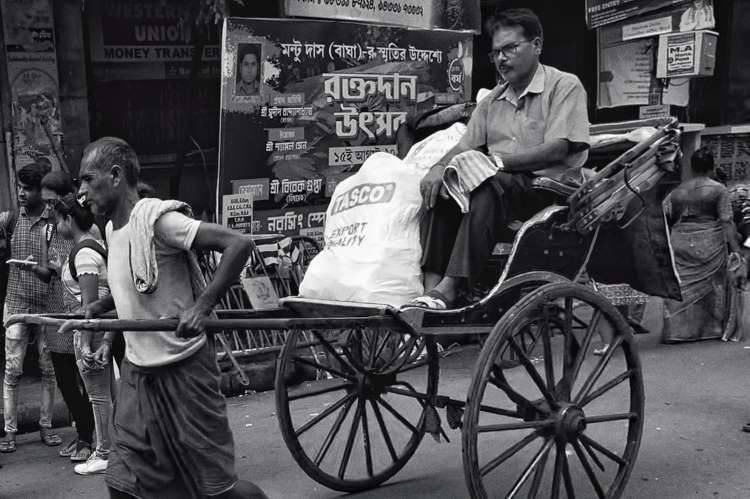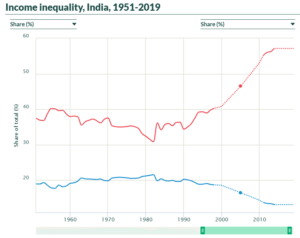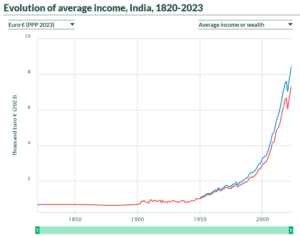
Over the last few decades, the inequality has widened dramatically, with serious consequences for the Indian society at large. The spread of consumerism has laid bare the widening gulf in access to resources and opportunities, symbolised by the rise of malls as dominant hubs of economic activity. Meanwhile, entrenched disparities in education and employment have further polarised socioeconomic outcomes. Equally worrying is the widening gap in healthcare spending, which disproportionately impacts marginalised groups. Addressing the root causes of this pervasive inequality requires a nuanced understanding of these interconnected issues, and a firm commitment to systemic reform.
Inequality is a complex and persistent challenge, deeply ingrained in societal structures. Despite technological advancements and economic growth, inequalities in income, wealth, and opportunities persist. The social and economic systems have embedded tendencies that not only sustain but also widen these disparities over time. These structural issues further widen inequalities, disparities in access to education and employment, and creates obstacles for disadvantaged communities in accessing healthcare.
READ I Aiming for stars: India’s space sector needs more than just technology
Shift from bazaars to malls
Economic growth often brings about increased consumer spending and lifestyle changes, one of which is the growing preference for malls over traditional bazaars. This shift is driven by factors such as convenience and the appeal of a more sophisticated shopping experience, particularly for urban middle- and upper-class consumers. Malls offer a wide variety of products, entertainment, and dining options in a clean and controlled environment.
Wealthier individuals, in particular, tend to avoid local bazaars, perceiving them as lower in quality, despite offering cheaper goods. In contrast, malls are associated with higher-quality products and warranties, as well as the social status they confer. Shopping at malls has become a symbol of financial success and modernity, further fueling their popularity over traditional markets.

This transition to mall-based shopping has significant implications for inequality. Large corporations, with substantial financial resources, often own and operate malls, consolidating economic power and diverting profits away from smaller local businesses. While malls create jobs, these are mostly low-paying positions such as security guards, maintenance workers, and retail clerks. Meanwhile, higher-paying jobs are typically reserved for a small segment of the population in managerial and administrative roles, exacerbating labour market polarisation and wealth disparity. The decline of bazaars further weakens local economies, as small business owners who rely on traditional markets struggle to survive, deepening economic inequality in the community.
Inequality in education
Education is a critical pathway to economic mobility. Inequalities in access to quality education create substantial barriers for the underprivileged, perpetuating cycles of poverty. Wealthier families can afford to send their children to private schools or better-funded public schools in affluent areas, giving their children a competitive advantage through superior facilities, qualified teachers, and a broader range of extracurricular activities.
Early childhood education, essential for long-term academic and life success, is often accessible only to wealthy families, leaving disadvantaged children behind from the outset. The rising cost of higher education further exacerbates inequality, as many low-income students are either unable to pursue further studies or must take on substantial debt, limiting their future economic opportunities and trapping them in cycles of poverty.
Wealth accumulation and asset inequality
The accumulation of wealth and assets is a key driver of long-term inequality, favouring the rich over the poor. Wealthy individuals have easier access to financial products such as stocks, bonds, and real estate, which help them preserve and grow their wealth over time. They can also use their assets as collateral to secure loans and make investments that further enhance their financial standing.

In contrast, poorer individuals often lack access to these financial opportunities, limiting their ability to build wealth and improve their economic prospects. Wealth inheritance also plays a role, as advantages are passed down from one generation to the next, perpetuating a cycle in which the rich continue to accumulate wealth while the poor struggle to make economic gains. As a result, the wealth gap widens, with economic expansion benefiting only a select few.
Inequality in employment opportunities
Employment is another area where systemic inequalities are evident. Social capital and networking, often prerequisites for high-paying jobs, are disproportionately accessible to the wealthy. Those with connections can secure better employment opportunities, while individuals from disadvantaged backgrounds face limited options.
Despite legal prohibitions, discrimination based on race, gender, and socioeconomic status persists in the labor market, leading to biased hiring practices and unequal compensation. Low-income individuals also face barriers to skill development and training programs, further limiting their prospects for upward mobility. This results in a cycle of low-wage employment and economic insecurity.
Health disparities play a major role in perpetuating inequality. Access to quality healthcare is often limited for low-income individuals, leading to untreated illnesses, higher mortality rates, and reduced ability to work and earn income. Those in poverty also have fewer resources to invest in preventive care, gym memberships, or healthy diets, contributing to chronic health conditions that diminish productivity and economic potential. Moreover, the psychological toll of poverty, including anxiety and depression, makes it even harder for individuals to find and retain employment, further entrenching inequality.
Political power and inequality
Inequality is also perpetuated by disparate access to political power and influence. Wealthy individuals and corporations often have the means to advocate for policies that serve their interests, such as deregulation, tax breaks, and subsidies. Their influence allows them to reshape legal and economic systems in their favor, often at the expense of the general population.
Wealthy individuals can support political campaigns and gain privileged access to policymakers, ensuring their voices are heard. Meanwhile, poorer individuals lack the resources to exert the same level of influence, leaving them underrepresented in decisions that affect their lives. This imbalance in political power reinforces existing inequalities, creating a cycle in which the rich become even wealthier and the poor remain marginalised.
Role of government intervention
Without substantial government intervention, these structural trends will continue to drive inequality. Effective policies and programs are needed to address these disparities. Ensuring equitable access to quality education for all children, regardless of financial status, is critical. This can be achieved through increased funding for public schools, financial aid, and scholarships, as well as support for early childhood education initiatives.
Expanding access to affordable healthcare, including preventive care, mental health services, and programs addressing social determinants of health such as housing and nutrition, can improve health outcomes for low-income individuals. Policies to combat discrimination and promote equal employment opportunities, such as skill development initiatives, support for small businesses, and affirmative action programs, are also essential.
Strengthening social safety nets, including food assistance programs, unemployment insurance, and affordable housing initiatives, can provide a critical buffer for those facing financial hardship and help reduce inequality.
Inequality is a deeply rooted issue that requires multifaceted solutions. Systemic tendencies in our economic and social systems, such as the shift toward malls, disparities in education and employment, and health inequities, perpetuate these divisions. Without significant government action and broad policy reforms, these disparities will continue to widen, threatening social cohesion and economic stability.
To address these challenges, policymakers must prioritise systemic reforms that target inequality at its core. Reforms in education and employment are the first steps toward ensuring equitable and inclusive economic practices. Expanding access to quality education and implementing affirmative action programs can help level the playing field in the workplace.
Simultaneously, efforts to promote equitable access to healthcare and prevent monopolistic practices in consumer markets can ensure a fairer distribution of wealth and opportunities. Through these policies, governments can begin to dismantle the systemic barriers that fuel inequality, paving the way for a more just and prosperous society.
(Aamir Ahmad Teeli is a doctoral fellow at the Department of Economics, Central University of Tamil Nadu. Dr Firdous Ahmad Malik is Assistant Professor of Economics, Department of Management, University of People, Pasadena, California, USA. Muzffar Hussain Dar is Assistant Professor at Dr BR Ambedkar School of Economics, Bangalore.)
